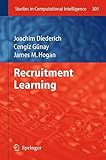Recruitment Learning / by Joachim Diederich, Cengiz Günay, James M. Hogan.
Tipo de material: TextoSeries Studies in Computational Intelligence ; 303Editor: Berlin, Heidelberg : Springer Berlin Heidelberg, 2011Descripción: x, 314 páginas recurso en líneaTipo de contenido:
TextoSeries Studies in Computational Intelligence ; 303Editor: Berlin, Heidelberg : Springer Berlin Heidelberg, 2011Descripción: x, 314 páginas recurso en líneaTipo de contenido: - texto
- computadora
- recurso en línea
- 9783642140280
- TA329-348
Springer eBooks
PART I: Recruitment in Discrete Time Neural Networks -- Recruitment Learning – An Introduction -- One-shot learning - Specialization and Generalization -- Connectivity and Candidate Structures -- Representation and Recruitment -- Cognitive Applications -- PART II: Recruitment in Continuous Time Neural Networks -- Spiking Neural Networks and Temporal Binding -- Synchronised Recruitment in Cortical -- The Stability of Recruited Concepts -- Conclusions.
This book presents a fascinating and self-contained account of "recruitment learning", a model and theory of fast learning in the neocortex. In contrast to the more common attractor network paradigm for long- and short-term memory, recruitment learning focuses on one-shot learning or "chunking" of arbitrary feature conjunctions that co-occur in single presentations. The book starts with a comprehensive review of the historic background of recruitment learning, putting special emphasis on the ground-breaking work of D.O. Hebb, W.A.Wickelgren, J.A.Feldman, L.G.Valiant, and L. Shastri. Afterwards a thorough mathematical analysis of the model is presented which shows that recruitment is indeed a plausible mechanism of memory formation in the neocortex. A third part extends the main concepts towards state-of-the-art spiking neuron models and dynamic synchronization as a tentative solution of the binding problem. The book further discusses the possible role of adult neurogenesis for recruitment. These recent developments put the theory of recruitment learning at the forefront of research on biologically inspired memory models and make the book an important and timely contribution to the field.
Para consulta fuera de la UANL se requiere clave de acceso remoto.


